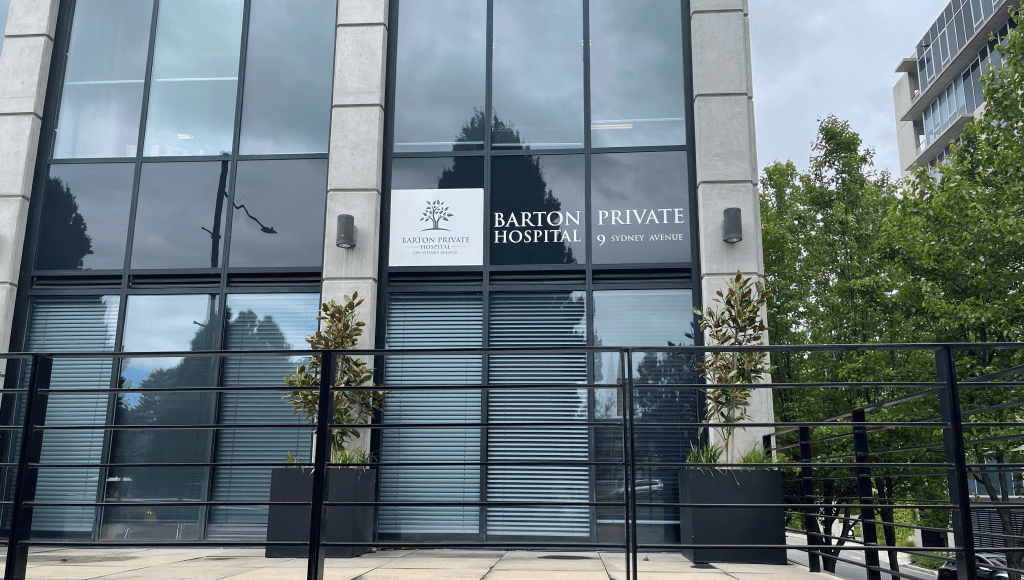Cura Group navigation
Hospital information
General information
Our procedures
Use the expand and collapse feature below to find more information, and patient information videos about the procedure you are undergoing.
A cone biopsy procedure is usually an outpatient surgery. It takes less than an hour to do, and you can usually go home on the same day. You’ll receive anesthesia so you won’t feel any pain, but the type of anesthetic depends on how much tissue they need to remove.
You might be given a:
- Local anesthetic, which numbs the area and helps you to relax
- Regional anesthetic, injected into your spine
- General anesthetic, which puts you to sleep for the procedure
The procedure is much like a Pap smear. You lay on your back with your feet in stirrups, and your doctor inserts an instrument into your vagina to keep it open. Then, they place a magnifying instrument called a colposcope near your vulva (the outer part of your genitals) and shine a light into your vagina so they can see your cervix and guide their tools.
Dilation and curettage (D&C) is a procedure to remove tissue from inside the uterus. A D&C is usually performed to diagnose and treat certain uterine conditions.
Endometrial Ablation is a procedure that surgically removes the lining of the uterus in order to reduce, or stop menstrual flow.
A hysteroscopy is the procedure in which a thin, lighted tube is used to examine the inside of the uterus and cervix. Hysteroscopy can be used in the diagnosis and treatment of several conditions such as abnormal bleeding, polyps or tumours inside the uterus, and adhesions.
Also known as ‘key-hole’ surgery, a laparoscopy is the procedure in which a laparoscope containing a fibre-optic camera and/or surgical heads is inserted through a small incision in the abdomen. Some of the many problems which can be diagnosed or treated by laparoscopy are infertility, reproductive problems, ectopic pregnancy, urinary disease and liver and pancreas cancer.
LLETZ stands for large loop excision of the transformation zone (of the cervix). In this procedure, the surgeon will remove a small segment of the cervix (the lower part of your womb or uterus) for examination.
Trans-vaginal tape repair is a surgical treatment for female stress incontinence. The procedure combines the use of mesh tape and a sling to support the urethra.
Vaginal repair using sutures or stitches to repair the prolapsed vaginal tissues is the commonest form of prolapse surgery. Repairing a prolapse with sutures is often referred to as a colporrhaphy and uses a patient’s own native tissue. No mesh is used in this surgery. This operation is usually recommended for women who have prolapse of the bladder (cystocele) or rectum (rectocele) or a combination of both. This surgery can be performed in combination with other procedures for urinary incontinence and hysterectomy.
Prolapse surgery can be performed with a spinal anaesthetic or a general anaesthetic. Incisions are made inside the vagina and the tissue supporting the vagina is strengthened with stitches. Sutures provide reinforcement of the weakened vaginal tissue. An additional stitch may be required at the top of the vagina or into the cervix to support the vagina or uterus from the sacrospinous ligament. For some women with complex prolapse, surgery may be reinforced with tissue taken through a small incision from the thigh (fascia lata). The vaginal incision is then closed with stitches that will dissolve after two to four weeks. At the end of the operation a catheter is inserted into the bladder to drain urine and a gauze pack is placed in the vagina to prevent bleeding. These will remain in place over night. Antibiotics will be given during the surgery and blood thinning medication is given after surgery.
Oocyte Pick Up (OPU) is the surgical procedure in the IVF cycle in which the eggs are collected or retrieved.
Sperm aspiration from the testicle (TESA).
Embryo transfer consists of depositing the embryos generated in the laboratory in the woman’s uterus, waiting for them to implant and give rise to a pregnancy. It is a simple and painless process that does not require anesthesia.
Normally, the embryo transfer is carried out in a room attached to the laboratory to avoid risks in the handling and transport of the embryos.
The success of the embryo transfer does not only depend on the quality of the embryos, but it is also important to assess the state and receptivity of the endometrium.
A blepharoplasty is a procedure which removes excess or sagging skin from upper and/or lower eyelids. The surgery is usually performed for cosmetic reasons however; it can improve sight in patients whose eyelids are obscuring their vision.
A chalazion is a lump on the eyelid that is usually caused by obstruction of the drainage duct of an oil gland within the upper or lower eyelid. Surgical removal of chalazion may become necessary if vision becomes obscured, or an astigmatism.
A Dacryocystorhinostomy (DCR) is an operation performed to unblock the nasolacrimal duct (tear duct).
Ectropion is a medical condition where the eyelid folds outward. Corrective surgery involves the removal of a small piece of the fold to tighten the muscles in the area.
An Endoscopic Brow Lift is a procedure in which a small endoscope is used to perform brow lift surgery. The scope is inserted into small incisions behind the hairline, providing surgeons with a clear view of the muscles and tissues beneath the skin.
Entropion is a medical condition where the eyelid folds inward. Corrective surgery involves the removal of a small piece of the fold to tighten the muscles in the area.
Excision of lesions is a procedure to remove growths such as lesions, moles and tumours from the skin, sometimes accompanied by frozen sections and followed by sutures or a graft. The most common reason for undertaking this procedure is for the removal of skin cancers such as Basal Cell Carcinoma which is the most common skin cancer on the face.
Ptosis is a drooping of the upper eyelid. Corrective surgery is performed by tightening the levator muscle through an incision in the normal crease in the upper lid.
A punctumplasty is be performed to widen the punctual opening to improve the drainage of tears in patients with punctual stenosis (the abnormal narrowing of the lacrimal punctum).
A wedge excision is a procedure which removes cancers from the edge of the eyelid.
A canthoplasty is a surgical procedure that tightens the area around the eye in order to correct a drooping appearance, and create an upward slant in the outer corner of the eye.
Cataract surgery is the surgical replacement of a cloudy lens with an artificial intraocular lens (IOL) implant to restore vision. The cloudy lens is broken up and removed with an ultrasound probe through a very small incision in the eye, and the artificial lens is inserted.
Enucleation of the eye is the surgical removal of the eye. It is a mostly used as treatment for malignant tumor in the eye or to relieve intolerable pain in a blind eye.
Evisceration is a surgical technique by which all intraocular contents are removed while preserving the scleral shell, and surrounding muscle.
An ICL procedure involves the insertion of an implantable contact lens in the front chamber of the eye, leaving the natural lens intact. The procedure, undertaken to correct short- or long-sightedness, is often used as an alternative to corrective laser procedures.
Intravitreal injections are used in the treatment of Age-Related Macular Degeneration. The Injections work by inhibiting the growth of abnormal blood vessels at the macula, and help to prevent leakage of these blood vessels.
A scleral buckle is when a silicone band is placed on the outer wall of the eye to close a retinal tear. Injections of gas or cryotherapy (intense cold) are also used to assist the buckle in closing the retinal tear.
Squint surgery involves tightening the extraocular eye muscles to change the eye position in order to correct a turned eye.
Glaucoma is characterised by elevated intraocular pressure associated with optic cupping and visual field loss. Trabeculectomy surgery lowers intraocular pressure by forming a new drainage to allow fluid to escape from the eye.
Vitrectomy is a surgery which removes the vitreous gel from the eye to assist in the repair of retinal detachments, macular holes and retinal membrane surgeries.
Dental implants are used to replace damaged or missing teeth. A dental implant procedure is where a screw or metal fixture is implanted into the jaw as the base for a new false tooth.
Dental restoration is a broad term used to encompass any dental procedure, artificial substance or structure with protects the mouth’s ability to eat and chew. The most common form of dental restoration are dental fillings.
When wisdom teeth have the potential to cause problems or become impacted, they may be removed surgically. In the procedure, the surgeon makes a small incision and extracts the tooth with forceps.
A tooth extraction is the removal of a tooth from the dental alveolus (socket) in the alveolar bone.
Achilles tendon repair surgery is a type of surgery to fix a damaged Achilles tendon.
The Achilles tendon is a strong, fibrous cord in the lower leg. It connects the muscles of your calf to your heel. It’s the largest tendon in your body.
In some cases, the Achilles tendon can tear, or rupture. This is usually due to a sudden, strong force. It can happen during tough physical activity. It can happen if you suddenly move faster or pivot on your foot. Having a foot that turns outward too much can increase your risk of a torn tendon. A ruptured Achilles tendon can cause pain and swelling near your heel. You may not be able to bend your foot downward.
During the surgery, an incision is made in the back of the calf. If the tendon is ruptured, the surgeon will stitch the tendon back together. If the tendon is degenerated, the surgeon may remove the damaged part of the tendon and repair the rest of the tendon with stitches. If there is severe damage to a lot of the tendon, the surgeon might replace part or all of your Achilles tendon. This is done with a tendon taken from another place in your foot. In some cases, the Achilles tendon repair surgery can be done as a minimally invasive procedure. This is done with several small incisions instead of one large one. It may use a special scope with a tiny camera and a light to help do the repair.
The purpose of an ACJ excision procedure is to remove a damaged Acromioclavicular Joint (ACJ). The ACJ may have been damaged from injury or arthritis.
Anterior cruciate reconstruction (ACL reconstruction) is a common procedure tin which a graft is used to reconstruct the ligament in the knee.
Acromioplasty is an arthoroscopic procedure used to treat impingement or bursitis of the shoulder.
Biceps reimplantation is the surgical treatment of bicep tendonitis of the shoulder. The surgeon cuts the tendon and reattachs it to the humerus bone therefore reducing pressure from the shoulder.
Carpal tunnel release is a surgery used to treat carpal tunnel syndrome. During the surgery, the surgeon will cut the carpal ligament to relieve pressure on the median nerve, and make more space for the nerve and tendons.
Dupuytren’s contracture is the development of a fibrous connection between the finger tendons and the skin of the palm resulting in a forward curvature or ‘clawing’ of one or more fingers. Treatment for Dupuytren’s contracture includes needling, injections and surgical procedures to sever the tissue causing the contracture.
Labral reconstruction is a procedure in which the native labrum is reconstructed using a graft.
Lateral release surgery is a procedure performed on the knee to realign the patella (kneecap). It is usually performed as an arthroscopic procedure.
Lateral collateral ligament (LCL) is a thin set of tissues present on the outer side of the knee, connecting the thighbone (femur) to the fibula (side bone of lower leg). It provides stability as well as limits the sidewise rotation of the knee. Tear or injury of LCL may cause instability of the knee that can be either reconstructed or repaired to regain the strength and movement of the knee.
LCL reconstruction involves replacement of the torn ligament with healthy strong tissue or graft. The tissue or graft can be taken either from the tissue bank (called allograft) or from the patient’s body (called autograft). The type of graft used, depends upon the condition of the patient and choice of your surgeon. Hamstring tendons are commonly used as autograft, as removal of such tendons does not affect the strength of the legs and effectively stabilizes the knee. A small incision is made on the lateral side of the knee to perform the LCL reconstruction. The procedure is done through an open incision and not arthroscopically. The thighbone and fibula bones are drilled precisely and accurately with specialized instruments to form tunnels. The ends of the tendon graft are passed through tunnels and are fixed by using screws, metal staples or large sutures. The knee undergone LCL reconstruction surgery is braced for 6-8 weeks.
Meniscal repair is a surgical procedure performed to repair torn knee cartilage.
Metatarsophalangeal (MTP) Joint Fusion is a surgical procedure in which the MTP Joint (big joint of the big toe) are fused together.
An open reduction and internal fixation (ORIF) is a procedure in which the fracture is reduced and fixated using wires, plates or screws.
PCL ruptures are less common than ACL ruptures and often do not require surgery. In certain situations where there is instability, pain or swelling of the knee joint, then surgery may be appropriate. The surgery is frequently carried out as a day surgery procedure.
All reconstructive procedures for the PCL require a graft. A common technique involves grafting the torn PCL with segments of the hamstring tendons. If the surgery involves the reconstruction of multiple ligaments at once, different graft materials may be used.
In general, most techniques utilise specially designed screws allowing secure immediate fixation of the graft material within bone tunnels drilled into the knee.
Syndesmosis ligament injuries often occur in conjunction with other ankle injuries, including sprains and fractures. If a damaged syndesmosis is left untreated, poor results often occur. The ankle joint is held in proper alignment by the ends of the tibia and fibula, which wraps around the inner and outer side of the ankle. If the syndesmosis is damaged, the ankle joint may become unstable.
A syndesmosis injury occurs when the foot twists outwards relative to the leg. This type of injury can occur when the ankle is forcefully twisted outwards, or when the foot is planted, and the leg twists inwards.
When the syndesmosis is repaired surgically, this is usually done with metal screws that pass through the fibula and into the tibia. These screws must be positioned once the syndesmosis has been placed in proper position and alignment. Either one or two screws may be used, depending on the type of injury and your surgeon’s preference.
Often, your surgeon will recommend removing the screws after about 3-4 months.
Rotator cuff repair procedures are most commonly performed by arthroscopic surgery, however in some cases open shoulder surgery may be necessary. The procedure involves removing any loose fragments from the area, and then surgically repairing the tendon.
Synovectomy is the surgical removal of the inflamed synovium (the tissue lining the joint), and is usually performed with an arthroscopy. The surgery is usually performed in cases of inflammatory arthritis where there is swelling causing pain, or limiting the range of motion of the digits and thumb.
Trigger Finger, also known as stenosing tenosynovitis or flexor tendonitis, is a condition where one of the fingers or thumb of the hand is caught in a bent position. Surgery may be undertaken to release the tight portion of the flexor tendon sheath.
Percutaneous disc decompression procedure is typically performed on an outpatient basis and requires only local anesthetic and mild sedation, alleviating the possible complications of open surgery and general anesthesia. This invasive procedure completes the continuum of care for patients who want a minimally invasive alternative to surgery.
Chronic persistent pain can arise from any one of a number of sources in the patients back or neck. Often it may be possible to pinpoint this to one or more joints of the spine (these are called zygapophysial joints, or incorrectly, facet joints). The fine-needle injection provides useful information about potentially problematic joints that help to guide the treatment approach. The joint injection is used primarily for diagnostic purposes and is not therapeutic in nature. However, if the block is successful and it breaks the pain cycle, up to a third of people having the injection notice a useful reduction in the severity of pain for a period of days or weeks.
Radiofrequency neurotomy uses heat generated by radio waves to target specific nerves and temporarily turn off their ability to send pain signals. The procedure is also known as radiofrequency ablation.
Spinal cord stimulation (SCS) and peripheral nerve stimulation (PNS) are two common examples of neuromodulation used for the treatment of pain and have been shown to be effective treatment options for many patients with refractory neuropathic pain.
Commonly referred to as a ‘tummy-tuck’, an abdominoplasty is a cosmetic or reconstructive surgery to remove excess skin and fat from the abdomen, and to tighten the stomach muscles.
Breast augmentation is the surgical increase of the size of woman’s breasts, usually through the use of breast implants.
A breast lift, or mastopexy, raises and firms the breasts by removing and tightening the surrounding skin.
Breast reduction surgery also known as reduction mammoplasty is a procedure to reduce the size of large breasts through the removal of excess fat, tissue and skin from the breasts.
The forehead lift or browlift is performed to correct sagging eyebrows or improve the lines of a person’s forehead.
An excision of melanoma procedure is the surgical removal of melanoma (a form of skin cancer).
Facelift, also known as meloplasty or rhytidectomy, involves surgical procedures that tightens and removes drooping skin.
Gynaecomastia surgery aims to remove the excess breast tissue, fat and skin from the male chest. Surgery usually consists of a combination of liposuction followed by glandular excision.
Labiaplasty surgery is a procedure which reduces and reshapes excess labia minora tissue of the vagina.
A lipectomy refers to any surgical procedure carried out to remove excess body fat. The most common of which is liposuction (a surgical procedure which suctions out excess fat).
Otoplasty, also known as ear correction surgery or ‘ear pinning’, is performed to move prominent or protruding ears closer to the head. It is done using permanent sutures to hold the ears in place.
Rhinoplasty is a surgical procedure which improves the appearance or function of the nose by reshaping the nasal bone and cartilage. It is performed by either an Otolaryngologist – head and neck surgeon, Maxillofacial surgeon, or Plastic surgeon.
Sentinel node biopsy is usually performed to identify whether cancer such as breast cancer or melanoma has spread to the lymphatic system. The procedure involves injecting a tracer material to help locate the nodes, and then removing the nodes for analysis.
A cheilectomy is the surgical removal of bone spurs from around the big toe joint. This procedure is done to reduce pain that results from hallux rigidus, stiffness of the big toe that can develop due to repetitive foot injuries and arthritis of the big toe joint. Cheilectomy is considered a joint sparing treatment because it preserves motion of the toe joint.
Derotation arthroplasty is the time-tested procedure for the repair of a symptomatic adductovarus deformity of the fifth toe.
Hallux valgus (bunions) is a very widespread misalignment of the big toes. The big toe noticeably drifts to the outer edge of the foot, where it also crowds the smaller toes. With the hallux valgus deformity the metatarsophalangeal joint is overstrained and as a result painful arthritis of the big toe (hallux rigidus) can develop.
The protruding bunion at the metatarsophalangeal joint becomes inflamed and painful and can swell.
The circumcision procedure (for infant males) involves the use of a Plastibell (a small plastic ring) which is slipped over the glans, and the foreskin is laid over it.
A cystoscopy is a procedure in which a thin flexible tube with a camera and light on the end is inserted through the urethra and into the bladder. The procedure is most commonly undertaken to investigate the bladder for any abnormalities.
A frenuloplasty is a procedure used to treat pain caused by tight or short frenulum of the penis.
A bladder biopsy is a diagnostic surgical procedure in which a doctor removes cells or tissue from your bladder to be tested in a laboratory. This typically involves inserting a tube with a camera and a needle into the urethra, which is the opening in your body through which urine is expelled.
A stent removal is the removal of a ureteral stent by a surgeon using a cystoscope. A cystoscope is a thin, flexible tube with a camera and a light that is inserted through the urethra.
A TRUS biopsy is a procedure where a tissue sample of the prostate gland is taken via a rectal ultrasound probe.
A vasectomy is a surgical procedure that sterilises a man by cutting the vas deferens, which are tubes that carry sperm from the testes to the penis.
- Follow Barton Private Hospital on social




